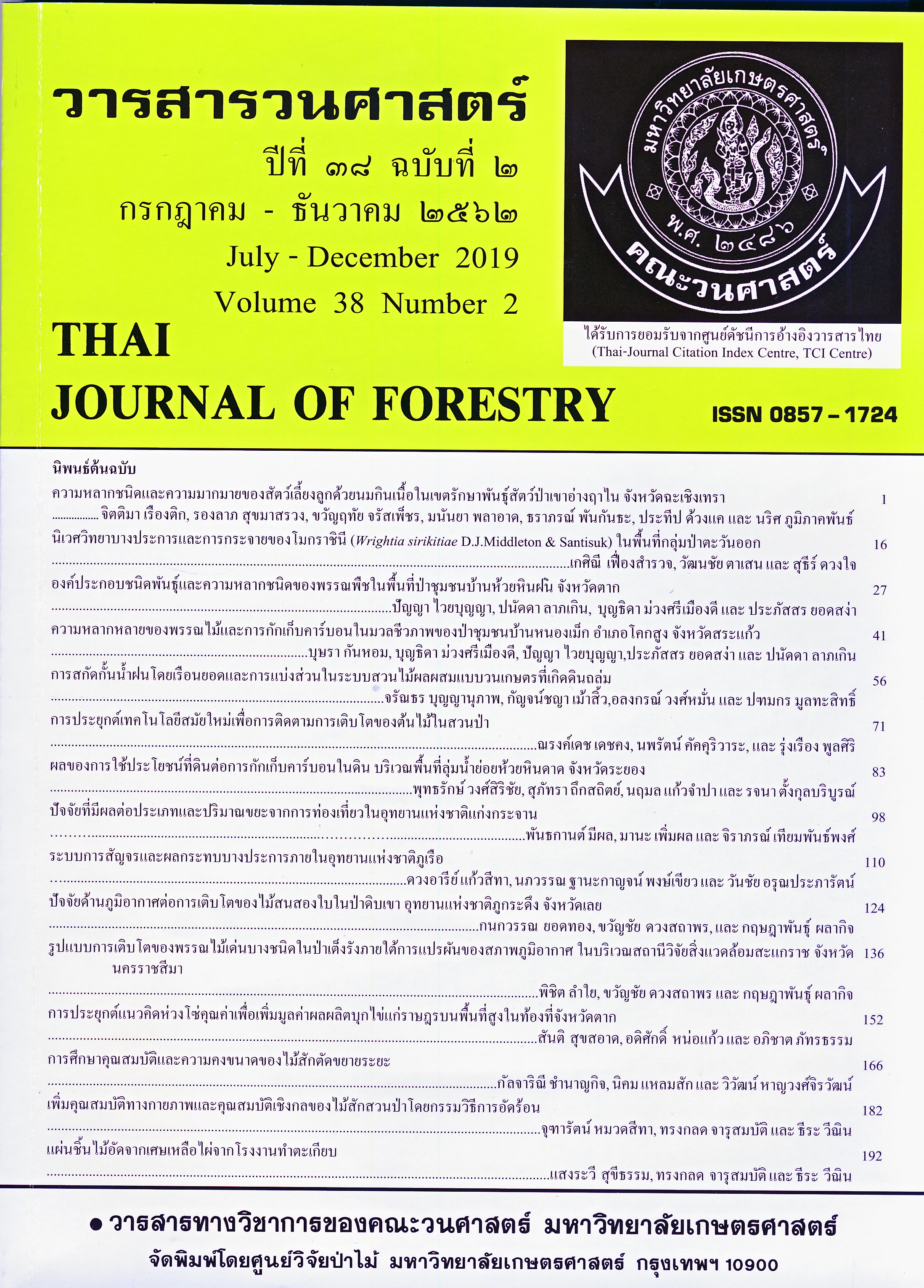ผลของการใช้ประโยชน์ที่ดินต่อการกักเก็บคาร์บอนในดิน บริเวณพื้นที่ลุ่มน้ำย่อยห้วยหินดาด จังหวัดระยอง
Main Article Content
บทคัดย่อ
การเปลี่ยนแปลงการใช้ที่ดินจากป่าธรรมชาติไปเป็นพื้นที่เกษตรกรรม ส่งผลทำให้มีการปล่อยปล่อยก๊าซ CO2 สู่บรรยากาศและเป็นสาเหตุสำคัญที่ทำให้เกิดภาวะโลกร้อนมากขึ้น การวางแผนการใช้ประโยชน์ที่ดินและการจัดการพื้นที่เพื่อเพิ่มประสิทธิภาพในการกักเก็บคาร์บอนทั้งในรูปมวลชีวภาพและการกักเก็บคาร์บอนในดินนั้น นับว่าเป็นเรื่องที่น่าสนใจในปัจจุบัน การศึกษาการกักเก็บคาร์บอนในดินในพื้นที่การใช้ประโยชน์ที่ดินที่แตกต่างกัน บริเวณพื้นที่ลุ่มน้ำย่อยห้วยหินดาด จังหวัดระยอง เพื่อประเมินการกักเก็บคาร์บอนในดินในพื้นที่ศึกษา ประกอบด้วย พื้นที่ยางพารา พื้นที่ยางพาราทิ้งร้าง พื้นที่ป่าฟื้นฟูด้วยไม้สัก และป่าดิบแล้งรุ่นสอง และเพื่อหาความสัมพันธ์ระหว่างปริมาณคาร์บอนในดินกับสมบัติดินบางประการ จากผลการศึกษา พบว่า ปริมาณคาร์บอนอินทรีย์ในดินเฉลี่ยของทุกประเภทการใช้ประโยชน์ที่ดินมีค่าสูงสุดที่ระดับดินบนชั้นบน (0-10 ซม.) และลดลงตามระดับความลึกดินที่เพิ่มขึ้น โดยปริมาณคาร์บอนสะสมในดินมีค่าสูงสุดในพื้นที่ป่าดิบแล้งรุ่นสอง (128.17 tC ha-1) รองลงมาคือ พื้นที่ป่าฟื้นฟูด้วยไม้สัก (86.17 tC ha-1) พื้นที่ยางพาราทิ้งร้าง (79.36 tC ha-1) และพื้นที่ยางพารา (48.42 tC ha-1) ตามลำดับโดยพบว่า ปริมาณคาร์บอนอินทรีย์ในดินที่ระดับดินบนชั้นบน (0-10 ซม.) ทุกการใช้ประโยชน์ที่ดินมีปริมาณสูงสุดในเดือนธันวาคมและต่ำสุดในเดือนมิถุนายน ในขณะที่ระดับความลึกดินบนชั้นล่าง (10-30 ซม.) และดินล่าง (30-50 ซม.) ของแต่ละเดือนต่างกันทุกประเภทการใช้ประโยชน์ที่ดิน เมื่อเปรียบเทียบความแตกต่างของปริมาณคาร์บอนอินทรีย์ในแต่ละประเภทการใช้ประโยชน์ที่ดินและแต่ละระดับความลึกดิน พบว่า มีความแตกต่างกันอย่างมีนัยสำคัญยิ่งทางสถิติ นอกจากนี้ความสัมพันธ์ระหว่างปริมาณคาร์บอนอินทรีย์ในดินกับสมบัติของดินบางประการ พบว่า ปริมาณคาร์บอนอินทรีย์มีความสัมพันธ์เชิงบวกกับความชื้นในดิน และมีความสัมพันธ์เชิงลบกับความหนาแน่นรวมของดิน
Downloads
Article Details
ข้าพเจ้าและผู้เขียนร่วม (ถ้ามี) ขอรับรองว่า ต้นฉบับที่เสนอมานี้ยังไม่เคยได้รับการตีพิมพ์และไม่ได้อยู่ในระหว่างกระบวนการพิจารณาตีพิมพ์ลงในวารสารหรือสิ่งตีพิมพ์อื่นใด ข้าพเจ้าและผู้เขียนร่วม (ถ้ามี) ยอมรับหลักเกณฑ์และเงื่อนไขการพิจารณาต้นฉบับ ทั้งยินยอมให้กองบรรณาธิการมีสิทธิ์พิจารณาและตรวจแก้ต้นฉบับได้ตามที่เห็นสมควร พร้อมนี้ขอมอบลิขสิทธิ์ผลงานที่ได้รับการตีพิมพ์ให้แก่วารสารวนศาสตร์ คณะวนศาสตร์ มหาวิทยาลัยเกษตรศาสตร์ กรณีมีการฟ้องร้องเรื่องการละเมิดลิขสิทธิ์เกี่ยวกับภาพ กราฟ ข้อความส่วนใดส่วนหนึ่ง หรือ ข้อคิดเห็นที่ปรากฏในผลงาน ให้เป็นความรับผิดชอบของข้าพเจ้าและผู้เขียนร่วม (ถ้ามี) แต่เพียงฝ่ายเดียว และหากข้าพเจ้าและผู้เขียนร่วม (ถ้ามี) ประสงค์ถอนบทความในระหว่างกระบวนการพิจารณาของทางวารสาร ข้าพเจ้าและผู้เขียนร่วม (ถ้ามี) ยินดีรับผิดชอบค่าใช้จ่ายทั้งหมดที่เกิดขึ้นในกระบวนการพิจารณาบทความนั้น”
เอกสารอ้างอิง
Benbi, D.K. and M. Chand. 2007. Quantifying the effect of soil organic matter on indigenous soil N supply and wheat productivity in semiarid sub-tropical India. Nutrient Cycling in Agroecosystems 79: 103-112.
Blake, G.R. and K.H. Hartge. 1986. Bulk density, pp. 363-382. In A. Klute, ed. Methods of Soil Analysis, Part 1: Physical and Mineralogical Methods. 2nd ed. American Society of Agronomy, Madison, Wisconsin.
Brady, N.C. and R.R. Weil. 2008. The Nature and Properties of Soils. 14th ed. Prentice Hall, Upper Saddle River, New Jersey.
Choi, M. and J.M. Jacobs. 2007. Soil moisture variability of root zone profiles within SMEX02 remote sensing footprints. Advances in Water Resources 30: 883-896.
Chunlei, Z., X. Jia, Y. Zhu and M. Shao. 2017. Longterm temporal variations of soil water content under different vegetation types in the Loess Plateau, China. Catena 158: 55-62.
De Blecourt, M., R. Brumme, J. Xu, M.D. Corre and E. Veldkamp. 2013. Soil carbon stock decrease
following conversion of secondary forests to rubber (Hevea brasiliensis) plantations. PLoS One 8: 69357.
Department of Soil Science. 1998. Introduction to Soil Science. 9th ed. Faculty of Agriculture, Kasetsart University, Bangkok.
Dokpikul, V. 2012. Estimation of Soil Loss and Soil Organic Carbon Content in Different Vetiver Experimental Plots at Vetiver Usage for Forest Development and Campaign Demonstration Center Unit 2, Sukhothai Province. M.S. Thesis, Kasetsart University.
Duchicela, J., S.T. Sullian, E. Bontti and J.D. Bever. 2013. Soil aggregate stability increase is strongly related to fungal community succession along an abandoned agricultural field chronosequence in the Bolivian Altiplano.
Journal of Applied Ecology 50: 1266-1273.
Franzluebbers, A.J. 2010. Achieving soil organic carbon sequestration with conservation agricultural systems in the southeastern United States. Soil Science Society of America Journal 74: 347-357.
Gao, L., M.A. Shao X.H. Peng and D.L. She. 2015. Spatial-temporal variability and temporal stability of water contents distributed within soil profiles at a hillslope scale. Catena 132: 29-36.
Gardner, W.H. 1986. Water content, pp. 1-21. In A.Klut, ed. Method of Soil Analysis. Part1 Physical and Mineralogical Methods. 2nd ed. American Society of Agronomy,Madison, Wisconsin.
Guo, L.B. and R.M. Gifford. 2002. Soil carbon stocks and land use change: a meta-analysis. Global Change Biology 8: 345-360.
Guoce, X., T. Zhang, Z. Li, P. Li, Y. Cheng and S. Cheng. 2017. Temporal and spatial characteristics of soil water content in diverse soil layers on land terraces of the Loess Plateau, China. Catena 158: 20-29.
Häring, V., H. Fischer, G. Cadisch and K. Stahr. 2013. Implication of erosion on the assessment of decomposition and humification of soil organic carbon after land use change in tropical agricultural system. Soil Biology
and Biochemistry 65: 158-167.
Hongxi, L., S. Blagodatsky, M. Giese, F. Liu, J. Xu and G. Cadisch. 2016. Impact of herbicide application on soil erosion and induced carbon loss in a rubber plantation of Southwest China. Catena 145: 180-192.
Hudson, J.M., S.A. Gherini and R.A. Goldstein. 1994. Modelling the global carbon cycle: nitrogen fertilization of the terrestrial biosphere and the “missing” CO2 sink. Global Biogeochemical Cycles 8: 307-333.
Jacobs, G.K., R.C. Dahlman and F.B. Metting. 2001. Carbon sequestration in terrestrial ecosystems: A status report on R&D Progress. In Proceedings of the First National Conference on Carbon Sequestration. Washington, D.C.
Jury, W.A., W.R. Gardner and W.H. Gardner. 1991. Soil Physics. 5th ed. John willey & Sons, Inc., New York.
Kheoruenromne, I. 2005. Soil Survey. 2 nd ed. Department of Soil Science, Faculty of Agriculture, Kasetsart University, Bangkok.
Lal, R. 1999. Soil management and restoration for C sequestration to mitigate the accelerated greenhouse effect. Progress in Environmental Science 1(4): 307-326.
Mena, M.M., J. Lopez, M. Almagro, C.B. Fayos and J. Albaladejo. 2008. Effect of water erosion and cultivation on the soil carbon stock in a semiarid area of South-East Spain. Soil and Tillage Research 99: 119-129.
Rasool, R., S.S. Kukul and G.S. Hira. 2008. Soil organic carbon and physical properties as affected by long-term application of FYM and inorganic fertilizers in maize–wheat system. Soil and Tillage Research 101: 31-36.
Sripo, P. 2011. Efficiency of Vetiver in Preventing Soil Loss and Soil Carbon Storage at Vetiver Usage for Forest Development and Campaingn Demonstration Center Unit 2, Sukhothai Province. M.S. Thesis, Kasetsart University.
Thompson, L.M. and F.R. Troch. 1978. Soil and Soil Fertility. 4 th ed. McGraw-Hill Inc., New York.
Undawatta, R.P., S.H. Anderson, C.J. Gantzer and H.E. Garrett. 2008. Influence of prairie restoration on CT-measured soil pore characteristics. Journal of Environmental Quality 37: 219-228.
Walkley, A. and I.A. Black. 1947. An examination of the Degtjareff method for determining soil organic matter and a proposed modification of the chromic acid titration method. Soil.
Sci. 37: 29-38.
Wright, J.T., G.W. Marcy, D.A. Fischer, R.P. Butler, S.S. Vogt, C.G. Tinney, H.R. Jones, B.D. Carter, J.A. Johnson, C. McCarthy and K. Apps. 2007. Four new exoplanets and hints of additional substellar companions to exoplanet host stars. The Astrophysical Journal 657: 533-545.


